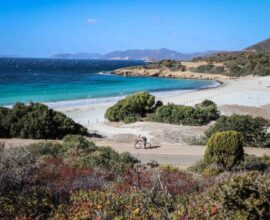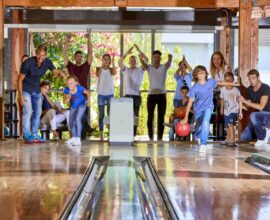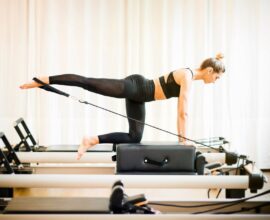Climbing Academy
Climbing Academy: learn about climbing
Holidays are the best time to try a new sport, and at Forte Village, an award-winning resort surrounded by the beautiful sea of Sardinia, the wide offer at the Sports Academy Center now has a new proposal: the Climbing Academy, where you can discover all the secrets of climbing.
Climbing is a sport that consists of climbing a rocky wall in a natural environment or an artificial wall with anchor points, relying only on the strength of legs and arms. It is, therefore, a sport that can be outdoor and indoor, using handgrips and feet as well as safety ropes.
The path taken during a climb is called a “climbing route”, and the practitioners of this sport are called climbers. The ascent, however, is called “progression” and there are two different types:
1. Solo progression: when a single climber faces the climb;
2. Rope progression: when more climbers are progressing. Generally, it is a small number of about two or three rock climbers.
Depending on the environment in which the clime takes place, it is possible to distinguish different climbing specialities:
• On rock: climbing rock walls in natural environments;
• on ice: ice climbing and/or frozen waterfalls;
• on mixed terrain: a route which has two or more types of terrain (for example ice and rock);
• Indoor: climbing in the gym where artificial panels called rocciodroms are used.
Climbing Academy: a sport to practice outdoors or in the gym
Climbing can be free or artificial, and the difference between the two practices is the use of artificial aids: in the first case, the climber can rely only on the strength of their body, while in artificial climbing, the climber uses tools that allow them to face the progression.
There are different types of free and artificial climbing, let’s have a look at them together:
• Free climbing: the climber faces the climb with bare hands, but this does not exclude the use of adequate equipment that includes rope, harness, descender, carabiners, nuts, friends and referrals. These instruments are not artificial aid but are used only and exclusively as insurance to limit damage in the event of a fall. A climbing route can be carried out:
– In moulinette: when climbing with the rope hanging from above;
– Onsight: when facing the climb without having observed other climbers or receiving any directions;
– Flash: when facing the climb with indications from other climbers;
– Worked (redpoint): a climb made after some attempts to identify the best sequence of movements.
• Traditional climbing: is a free climbing style in which you can remove the safety anchors. It is the most popular type of climbing and is used to large mountain walls;
• Sport climbing: unlike traditional climbing, this style of climbing is based on permanent anchors fixed to the rock that ensure protection. It is considered a type of free climbing because the equipment is used only as insurance and does not help in any way the climber during the route;
• Climbing without guarantee: is a type of free climbing in which there is no use of protection. This category includes bouldering, known in Italian as “sassismo”, and extreme sport called free solo;
• Artificial climbing: involves the use of tools such as nails, bolts, nylon lanyards, brackets or Skyhook, which help the progression. Artificial climbing includes: ice climbing, indoor climbing – practised indoors on structures consisting of panels on which there are resin sockets or other material, and climbing on a tree also called tree climbing.
Climbing Academy: 10 Benefits of Climbing for Body and Mind
Climbing is a real total body workout that involves almost all muscles of the body and requires balance, flexibility and good coordination. In addition, it is a sport that helps to take care of the health of the body and mind.
Here are the benefits of climbing:
1. Strengthens and tones muscles and shoulders;
2. It is excellent cardiovascular training;
3. Improves movement skills and coordination;
4. Improves balance, agility and flexibility;
5. Sculpts the body and increases body elasticity;
6. Helps to burn calories and lose weight;
7. Increases self-esteem and self-confidence;
8. Helps manage anxiety and relieve stress;
9. Promotes socialization and sharing;
10. Develops great physical and mental resistance.
Climbing Academy: the new sports academy at Forte Village
Indoor climbing combines the benefits of traditional outdoor climbing with the advantage of being able to do it on artificial walls inside equipped gyms such as the Climbing Academy of Forte Village, the Resort in Santa Margherita di Pula in the province of Cagliari.
Within the Climbing Academy, children and teenagers, together with the instructors of Forte Village, will be able to push themselves with an exciting sport that celebrates its first Olympic appearance at the Tokyo 2020 Summer Games scheduled from 23rd of July to the 8th of August 2021.
According to the original calendar, the Games of the XXXII Olympics were supposed to take place in Tokyo, Japan, from the 24th of July to the 9th of August 2020, but the dates were postponed by one year due to the pandemic of COVID-19.
The Climbing Academy is just one of the many sports Academies at Forte Village that offers courses in traditional sports and boxing, fencing, triathlon, water sports, specific training courses and personalized training sessions coached by great international champions.
Do you want to discover all the secrets of climbing and have a dream holiday in a true paradise? Book your stay at Forte Village Resort in Sardinia.






